Discovering Local Drip Tape Irrigation Solutions


Overview of the Topic
Definition and Importance
Drip tape irrigation is a precise method of delivering water directly to the root zones of plants. This approach minimizes wastage of water, making it an essential technique in regions where water resources are limited. The significance of drip tape irrigation extends beyond just water conservation; it also enhances crop yields. By providing consistent moisture at optimal levels, crops can thrive better, resulting in healthier plants and increased productivity. Thus, farmers aiming for sustainable agriculture should consider this irrigation method seriously.
Current Trends
As climate change intensifies, farmers are increasingly adopting advanced irrigation systems. Drip tape irrigation is gaining traction not only for its efficiency but also due to innovations in technology. For instance, merging drip tape systems with moisture sensors allows farmers to monitor soil conditions in real-time. This integration leads to more informed decision-making, maximizing both water savings and crop output.
Key Techniques and Practices
Step-by-Step Guide
- Assess your land: Understand the soil type and the specific water needs of your crops.
- Choose suitable drip tape: Select based on flow rate, emitter spacing, and tape thickness fitting your crops.
- Plan your layout: Design an efficient layout that minimizes the number of connectors and reduces pressure loss.
- Installation: Lay the tape along the crop rows. Ensure emitters are directed towards the plant roots.
- Connect to water source: Attach the drip tape to a pump or gravity-fed system.
- Test the system: Before the planting season, ensure everything operates correctly.
Tools and Equipment Needed
- Drip tape of choice.
- Connectors and fittings to secure the tape.
- Water source, such as a pond, well, or municipal supply.
- Timer or moisture sensors for automated irrigation.
- Pressure regulator to maintain optimal flow.
Challenges and Solutions
Common Obstacles
Farmers often face issues such as clogged emitters, uneven water distribution, and system leaks. These problems can arise from sediment buildup or improper installation. Addressing these concerns early can prevent more significant losses during the growing season.
Innovative Solutions
In recent years, the agricultural sector has developed effective solutions to tackle these challenges. Regular cleaning of the drip tape can help minimize emitter clogging. Implementing on-site filtration systems, like sand or disc filters, assists in reducing particulates entering the system. Additionally, using biodegradable materials for drip tape may alleviate environmental concerns associated with disposal.
By understanding both the advantages and the challenges of drip tape irrigation, farmers can make informed decisions about implementing this system effectively in their operations.
Foreword to Drip Tape Irrigation
Drip tape irrigation is a compelling practice that captures the attention of farmers and agricultural enthusiasts alike. The need for efficient water management in farming is undeniable, making this method essential. By focusing on precision in targeting water, drip tape offers advantages that distinctly set it apart from traditional irrigation methods.
Definition and Overview
Drip tape irrigation involves the application of water directly to the base of plants through a network of tubing. This tubing, characterized by small holes or emitters, allows water to seep into the soil slowly. As a result, evaporation losses are minimized and water is used more efficiently.
The system is both straightforward and adaptable, suitable for various crops and soil types. For instance, the simplicity of installation is a significant factor that appeals to many farmers. It can be implemented in diverse environments, whether in the fields or greenhouses, making it an attractive option across regions.
Importance in Modern Agriculture
Modern agricultural practices face multiple challenges, including water scarcity and the need for sustainable crop production. Drip tape irrigation addresses these issues by enhancing water use efficiency and reducing the volume of water required for irrigation. According to research, it can lead to water savings of up to 50 percent compared to conventional methods.
Moreover, its precision in delivery promotes healthier growth for plants. Each plant receives the necessary moisture at the right time, reducing competition from weeds that may thrive in other irrigation setups.
"With the impending threats of climate change, adopting efficient irrigation systems like drip tape is not just beneficial but essential for sustainable agriculture."
Benefits of Drip Tape Irrigation
Drip tape irrigation has become increasingly relevant for farmers aiming to optimize water usage while achieving impressive yields. This section will delve into several key benefits of using drip tape irrigation. Each benefit is vital not only for short-term results but also for sustainable agricultural practices over time.
Water Conservation
Water conservation is one of the primary advantages of drip tape irrigation. This method delivers water directly to the root zone of plants, minimizing evaporation and runoff. Unlike traditional irrigation methods, which may flood entire fields, drip tape ensures that water is used efficiently. Research shows that up to 50% more water can be conserved when utilizing drip systems compared to conventional watering techniques.
Farmers should also consider the implications of water scarcity due to climate change. Effective water management strategies draw increasingly from systems like drip tape irrigation to address these challenges. Less water usage not only reduces costs but also enhances the resilience of crops under drought-like conditions.
Improved Crop Yields
Crop yield enhancement is another significant benefit of drip tape irrigation. By providing a consistent water supply, plants can grow healthier and more robust. Regular and precise watering supports better nutrient uptake and improves overall growth patterns. This leads to increased production when managing crops like tomatoes, peppers, and melons, which highly appreciate consistent moisture levels.
Data indicate that farmers can see yield increases of anywhere from 20% to 90% by switching to drip irrigation, especially in areas where soil moisture varies considerably. This potential for improved yields makes drip tape an attractive option for both small and large-scale operations.
Reduced Weed Growth
Weed growth often poses a challenge for farmers, competing with crops for vital resources such as water and nutrients. Drip tape irrigation contributes to reduced weed pressure. Since the system directs water specifically to the crops, weeds that thrive in wet conditions can be limited. This targeted watering also means that less overall area is saturated, further decreasing the conditions under which weeds tend to flourish.
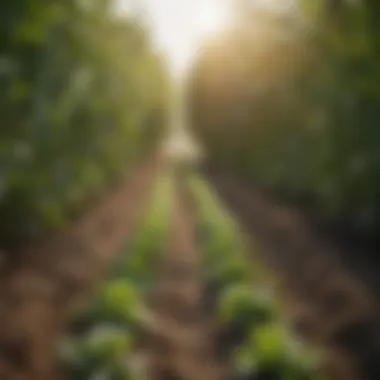
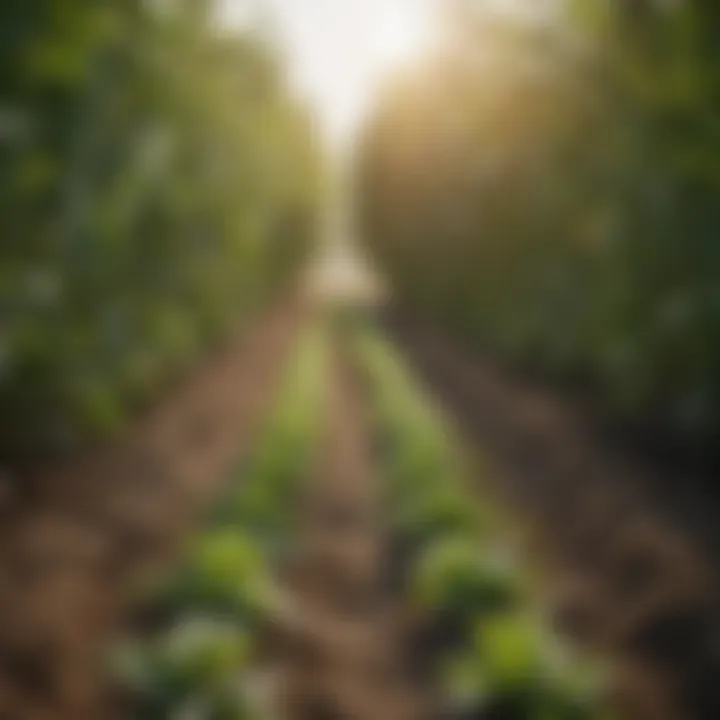
Farmers implementing drip tape systems often find that additional labor for weed management can decrease significantly. With fewer weeds, crop health typically improves due to reduced competition, ultimately resulting in better quality produce.
Soil Health Maintenance
Soil health is crucial for sustainable farming practices, and drip tape irrigation positively impacts it. The precise application of water helps maintain proper soil structure and moisture levels. When water is evenly distributed, it reduces soil erosion and prevents problems such as compaction, which can negatively affect root growth.
Moreover, drip irrigation systems can be designed to incorporate necessary nutrients directly into the water supply. This is known as fertigation. Such a practice enhances nutrient efficiency and minimizes runoff, protecting water sources nearby.
In summary, the benefits of drip tape irrigation include effective water conservation, improved crop yields, reduced weed growth, and enhanced soil health. Understanding these factors allows farmers to make informed decisions about their irrigation practices, aligning them more closely with sustainable agricultural goals. Investing in some drip tape technology may yield even greater returns on investment than previously imagined.
Searching for Drip Tape Irrigation Solutions Near You
When farmers seek to implement drip tape irrigation, finding the right resources in their vicinity is crucial. The nature of this agricultural method necessitates suitable solutions that cater to specific climate, soil, and crop requirements. Local options often provide personalized services, while online resources can widen the search and potentially offer competitive pricing. This section delves into two main avenues for acquiring drip tape irrigation solutions: local suppliers and retailers, as well as online marketplaces.
Local Suppliers and Retailers
Working with local suppliers and retailers presents several advantages. Proximity ensures that farmers have access to immediate assistance and knowledge about the regional environment. Local suppliers usually possess a strong understanding of the types of crops grown in the area and the specific irrigation challenges that may arise. Moreover, they can recommend drip tape systems that align with local regulations and best practices.
Farmers can benefit from visiting local agricultural stores that specialize in irrigation equipment. When visiting these shops, consider asking the following:
- What brands of drip tape do you carry?
- Do you provide installation services or assistance?
- Are there any local farmers using your products that I could speak with?
Building a rapport with local suppliers can also lead to better pricing negotiations and opportunities for bulk purchases. In addition, many suppliers provide ongoing support and maintenance services, making them valuable partners in farming operations.
Online Resources and Marketplaces
The internet has transformed how farmers shop for irrigation solutions. Online marketplaces such as Amazon and specialized agricultural websites allow farmers to compare prices and product specifications easily. This can help in making informed decisions about which products best meet their needs.
Using online platforms has several advantages:
- Wide selection: Farmers can access a variety of brands and types of drip tape systems that may not be available locally.
- User reviews: Reading feedback from other users offers insights into the performance and reliability of various products.
- Delivery options: Many online stores offer shipping directly to a farmer's location, saving time and effort compared to transport from local retailers.
However, caution is essential when purchasing online. It is vital to ensure that the chosen supplier has a good reputation and reliable return policies. Farmers should also check if the product meets local agricultural regulations before committing to a purchase.
"Finding the right irrigation solution starts with understanding your own needs and available resources."
Combining local knowledge with online research can create a robust approach to sourcing drip tape irrigation systems. This strategy allows for a balance between personal service and the convenience of modern technology, empowering farmers to make the best decisions for their agricultural practices.
Factors to Consider When Choosing Drip Tape Irrigation
Choosing the right drip tape irrigation is crucial for maximizing efficiency and ensuring a successful agricultural operation. Understanding the specific factors that influence your selection can lead to better water conservation and enhanced crop yields. The primary aspects include crop type compatibility, soil conditions, and the size of the agricultural area. Each of these factors plays a critical role in determining the effectiveness of the irrigation system.
Crop Type Compatibility
The type of crops you plan to grow significantly affects the choice of drip tape irrigation. Different crops have varying water needs and root structures, which influence how water is delivered through the system. Some crops may require a steady flow of water directly to the roots, while others would benefit from a more distributed method.
For example, leafy greens may do well with more frequent shallow watering, while root vegetables prefer a deeper moisture profile. It is essential to assess various crop needs to ensure that the selected drip tape system matches those specifications effectively. Consider conducting research on specific varieties of crops, including how they have responded to irrigation systems in similar conditions.
Soil Conditions
The soil type in your agricultural area determines how water is absorbed and retained. Sandy soils drain quickly and may require more frequent watering, while clay soils retain moisture longer but can become waterlogged. When choosing a drip tape system, it is vital to evaluate the soil characteristics.
- Soil texture influences the irrigation system's placement and emitter spacing. Precise calculations based on infiltration rates will ensure that the system performs optimally.
- Soil pH and structure can influence crop health, so a thorough soil test before installation is recommended. This knowledge helps tailor the irrigation method precisely and ensures the long-term benefits of an effective drip tape system.
Size of the Agricultural Area
The scale of your farming operation is another important consideration when choosing drip tape irrigation. Larger agricultural areas may necessitate a different approach compared to small-scale farming. Here are some points to consider:
- Length and layout: Larger fields may need longer runs of tape and optimal patterns to reach all parts of the field evenly.
- Pressure requirements: Bigger systems may require more robust pumps to maintain adequate pressure across the entire length of the irrigation line.
- Budget considerations: The cost of the system will scale with the size of the area. It’s critical to evaluate both initial investment and ongoing maintenance costs.
Understanding the interaction among these factors can guide your decision-making process. By taking them into account, you can implement an irrigation system that aligns with your agricultural goals while promoting sustainability.
"Investing in the right drip tape system is not just about efficiency; it’s about nurturing a sustainable future for agriculture."
Ensuring compatibility among crop types, knowledge of soil conditions, and an understanding of the area size will set a solid foundation for your drip tape irrigation strategy.
Installing Drip Tape Irrigation
Installing drip tape irrigation is a critical step for farmers looking to improve the efficiency and effectiveness of their watering practices. This method ensures that crops receive water directly to their roots, minimizing waste and optimizing growth. Understanding how to properly install a system can result in significant water savings, better yield, and healthier soil.
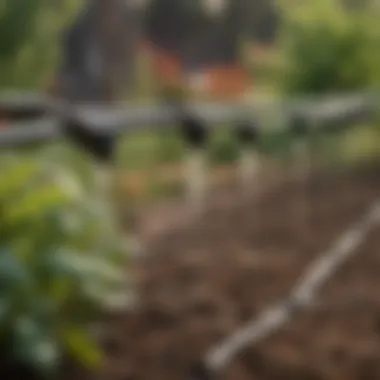
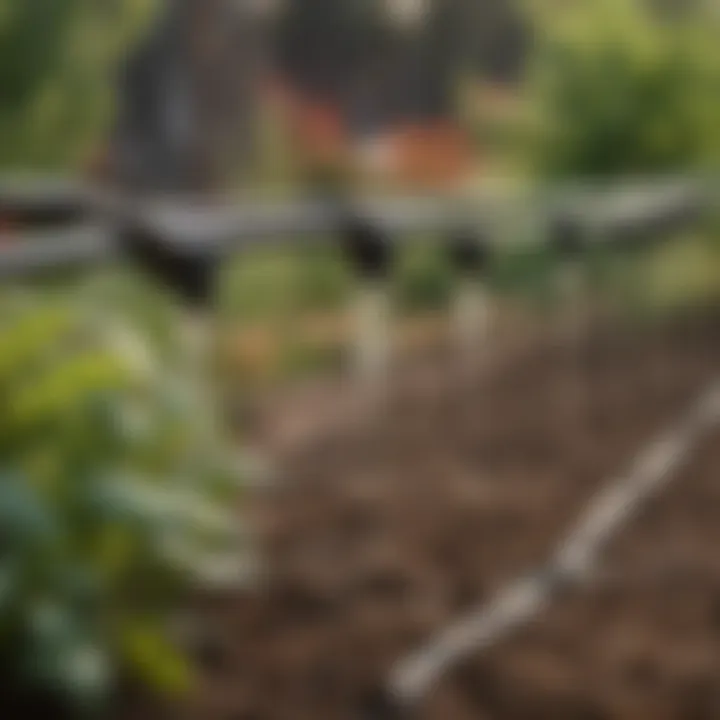
When one thinks about the process of installation, several factors come into play including proper planning, understanding the environment, and anticipating future maintenance. Each of these elements plays a vital role in maximizing the benefits of drip tape irrigation.
Preparation Steps
Before one begins the installation of a drip tape irrigation system, adequate preparation is essential. The following steps can help ease the process:
- Measure the Field: Accurately measuring the area allows for proper planning regarding the amount of drip tape required.
- Choose the Right Tape: Selection of drip tape should be based on the specific crops being grown and the soil types. Different tapes have varying flow rates and emitter spacing.
- Check for Obstructions: Identifying any rocks, roots, or other obstacles in the soil can help prevent damage during installation.
- System Layout Design: Concocting a design that allows for uniform distribution of water is essential. Water pressure and the layout of the field should direct the design.
- Gather Necessary Tools: Tools like spades, trowels, and connectors should be collected beforehand to minimize downtime.
Proper planning is the bedrock of effective installation. A well-thought-out system can significantly improve irrigation results.
Installation Procedures
Once the preparation steps are complete, the installation can begin. A systematic approach will ensure that the drip tape irrigation system functions as intended:
- Prepare the Soil: Loosen and level the soil in the areas where drip tape will be laid. This facilitates better contact between the tape and soil, enhancing moisture absorption.
- Set Up the Mainline: Install a sturdy mainline to deliver water from the source to the field. The mainline needs to be pressure-tested for leaks before proceeding.
- Lay Out the Drip Tape: Starting at one end of the field, lay out the drip tape following the designed layout. Ensure there are no twists or kinks in the tape which could impede water flow.
- Attach Emitters and Connectors: Connect the emitters and any necessary connectors firmly to ensure no leakage occurs. It is crucial for the system's efficiency.
- Test the System: Before finalizing installation, test the entire system. Ensure that water flows evenly from each emitter, and make adjustments as needed.
- Cover with Soil: Once everything is confirmed to be working, cover the drip tape with a thin layer of soil for protection and enhanced efficiency.
Completing these installation procedures correctly will facilitate optimal performance of the drip tape irrigation system, leading to enhanced water efficiency and crop performance.
Maintenance of Drip Tape Irrigation Systems
Maintaining drip tape irrigation systems is vital for ensuring their longevity, efficiency, and effectiveness. Proper maintenance helps farmers maximize their water use and crop yields. A well-maintained drip tape system can significantly reduce instances of clogged emitters or leaks, which in turn ensures that water reaches the plants efficiently. Moreover, regular maintenance can help identify potential issues before they escalate, thus reducing overall repair costs in the long term.
Regular Checks and Repairs
Conducting regular checks on the drip tape system is essential. Farmers should inspect the entire system to ensure all components are functioning properly. Here are some specific areas to focus on:
- Emitter functionality: Clogged emitters can lead to uneven water distribution.
- Tapes for leaks: Any signs of leakage can waste water and damage crops.
- Connections: Ensure all fittings and connectors are secure.
Performing routine maintenance checks not only ensures optimal performance but also extends the life of the system. Repairs, when needed, should be conducted promptly. For instance, replacing a worn or damaged section of drip tape is easier and cheaper than replacing an entire system.
Winterizing the System
Winterizing the drip tape irrigation system is important for regions that experience freezing temperatures. If water leftover in the system freezes, it can expand and cause damage. Here are the steps to winterize:
- Drain the System: Remove all water from the drip tape.
- Inspect: Check for any damages from the growing season.
- Store Properly: Roll up the drip tape and store it in a dry place away from sunlight.
Taking these steps ensures that the system is not only preserved for the next growing season but also enhances its operational efficiency.
Remember, maintenance is not just a checklist item, it’s a commitment to efficiency and sustainability in farming.
Cost Considerations for Drip Tape Irrigation
Cost is a critical factor influencing the decision to adopt drip tape irrigation systems. Investing in such systems demands careful planning and assessment to achieve economic viability. Understanding the associated costs forms the backbone of informed decision-making for farmers. This section outlines initial investments and potential long-term savings that come with drip tape irrigation.
Initial Investment
Initial investment refers to the upfront costs that farmers must incur to set up a drip tape irrigation system. This can include the prices for materials, labor, and equipment. The primary components of the initial setup generally encompass:
- Drip tape material: The price of the tape varies by quality and length. Some farmers opt for thicker tapes, which are more durable and effective but come at a higher cost.
- Pump systems: Farmers often need a pump to deliver water through the irrigation system. The choice between electric, diesel, or solar pumps affects overall costs significantly.
- Filtration systems: Proper filtration prevents clogging, which is crucial for the longevity of the drip tape. Selecting the right filter system can add to costs.
- Installation expenses: Some farmers may choose a professional installation service, while others may do it themselves, depending on the complexity of the system.
Overall, initial investments can range from hundreds to thousands of dollars, depending on the scale of operation and specific needs.
Long-Term Savings
Though the setup costs may seem high initially, drip tape irrigation can lead to significant long-term savings. These savings come from various elements of the system’s operation:
- Water Efficiency: Drip tape systems direct water precisely to the plant's roots, minimizing wastage. This targeted watering leads to reduced water bills and conserves this precious resource.
- Reduced Labor Costs: Over time, automated systems lower the need for manual watering. Farmers can allocate labor to other critical tasks, thus balancing their workforce more effectively.
- Enhanced Crop Yields: With more efficient water delivery and improved soil conditions, crops often show better growth and yield. This leads to increased profits per acre over time.
- Lower Fertilizer Expenses: Fertigation, or applying fertilizers through the drip system, allows better absorption of nutrients. This method can lead to reduced fertilizer usage, further decreasing costs.
Comparative Analysis of Irrigation Methods
In the quest for optimal agricultural efficiency, understanding the various irrigation methods is crucial. This section focuses on comparing traditional methods with modern solutions. Farmers must evaluate these options to determine the best fit for their specific needs. This analysis is particularly relevant for those considering transitioning to drip tape irrigation, as it highlights the distinct advantages and limitations of each method.
Drip Irrigation vs. Sprinkler Systems
Drip irrigation and sprinkler systems serve the fundamental purpose of delivering water to crops, yet they do so in significantly different ways. Drip irrigation works by delivering precise amounts of water directly to the plant roots through a network of tubes and emitters. This targeted approach minimizes evaporation and runoff, leading to greater water efficiency. Farmers using drip irrigation often report improved crop yields and reduced water usage.
Sprinkler systems, on the other hand, simulate rainfall by distributing water through spray heads across a wider area. They are easier to install and can cover larger fields. However, they do present drawbacks such as higher evaporation rates and the potential for water wastage. In windy conditions, sprinklers may also distribute water unevenly, which can adversely affect crop health.
Consider the following points when comparing these methods:
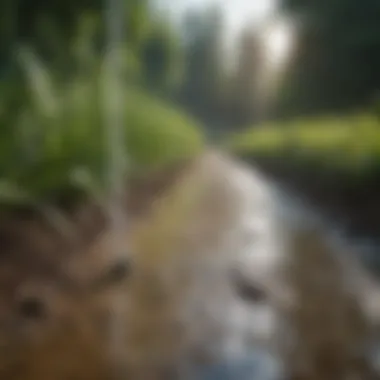
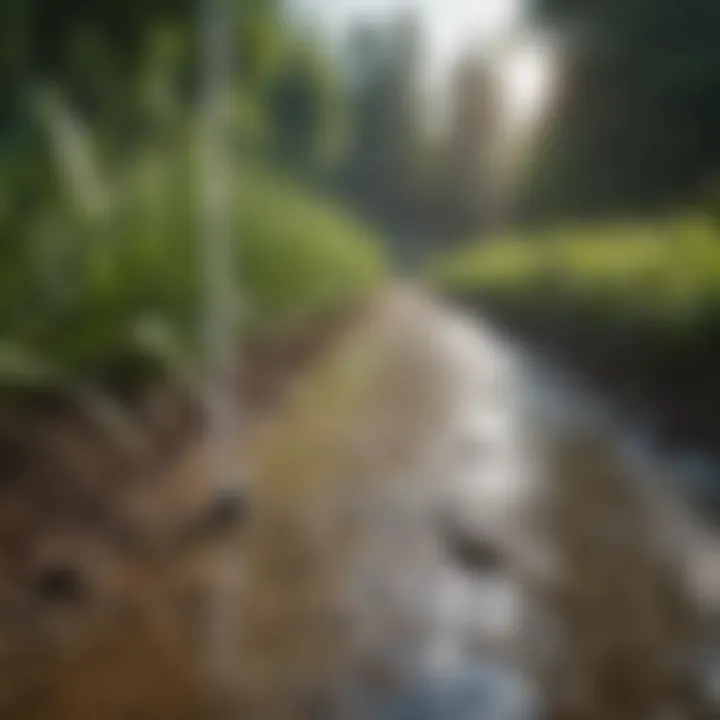
- Water Efficiency: Drip systems generally use less water than sprinklers.
- Crop Health: Targeted watering in drip systems can promote healthier plants.
- Installation Complexity: Sprinkler systems are often simpler to set up and manage.
- Field Coverage: Sprinklers can service larger areas without the need for extensive tubing.
Conventional Methods vs. Drip Tape
Conventional irrigation methods, such as flood or furrow irrigation, involve distributing water over the field's surface or into furrows. These methods are often less efficient, leading to water loss through runoff or evaporation. Moreover, they can lead to soil erosion and nutrient depletion over time. In contrast, drip tape, a form of drip irrigation, focuses on delivering water directly at the soil level.
The advantages of drip tape compared to conventional methods include:
- Reduced Water Usage: Drip tape conserves water by minimizing evaporation and deep percolation.
- Soil Retention: Direct application helps maintain soil structure and health.
- Precision in Application: Farmers can control the water and nutrient delivery to specific crop types.
"Drip tape irrigation not only conserves water but also enhances soil health, which is essential for sustainable agriculture."
In summary, the comparative analysis of irrigation methods is essential. Different methods may suit different farming operations, but understanding their benefits and limitations can enhance decision-making. Transitioning to a more efficient system like drip tape can lead to better resource management and improved crop performance.
Case Studies of Successful Drip Tape Irrigation Implementation
The exploration of real-world applications of drip tape irrigation provides invaluable insight for farmers and agricultural enthusiasts. Case studies illustrate not only the effectiveness of this method but also the diverse conditions and crops that benefit from it. By examining these successful implementations, we can better understand the advantages, challenges, and practical considerations surrounding drip tape irrigation.
Regional Examples
Various regions have embraced drip tape irrigation with notable success. In California's Central Valley, for instance, farmers have adopted this technology to maximize water efficiency in a water-scarce environment. The area relies on agricultural yields from crops like tomatoes and peppers. By utilizing drip tape, growers have reported significant reductions in water usage while maintaining or even increasing their harvests. This shift contributes to both the economic viability of their operations and the overall sustainability of agricultural practices in the region.
In another example, farmers in Israel have pioneered drip tape irrigation, adapting it to arid climates. Here, the technology has transformed barren lands into productive agricultural fields. Their experiences underscore not just immediate crop benefits but also long-term soil health improvement as water penetrates more deeply and evenly.
Sustainable Practices
Successful case studies highlight that drip tape irrigation aligns well with sustainable agriculture practices. Many farms incorporate eco-friendly materials for their irrigation systems. For example, using biodegradable drip tapes reduces plastic waste in the environment. Furthermore, these practices prevent soil erosion by minimizing surface runoff, promoting enhanced moisture retention.
Farmers utilizing drip irrigation often perform soil testing to determine the optimal depth and layout for their system. This data-driven approach allows for precise water delivery, enhancing crop health and reducing the need for chemical inputs. Additionally, many of these successful farms engage in crop rotation and intercropping, which work in tandem with drip irrigation. These practices create a balanced ecosystem, further supporting sustainable agriculture.
"Understanding practical implementations of drip tape irrigation can pave the way for improved methods and long-term agricultural success."
Future Trends in Drip Tape Irrigation
The area of drip tape irrigation is evolving rapidly and understanding these future trends is essential for farmers and producers. This knowledge helps in making informed decisions that can directly impact productivity and sustainability. As we look at what lies ahead, several key components demand attention. These include technological advancements, increasing adoption rates, and their implications for agriculture.
Technological Innovations
Technology plays a crucial role in enhancing the effectiveness of drip tape irrigation. Advances in materials used for drip tape are one area that is receiving significant attention. Many companies now produce stronger and more durable tapes that can withstand the rigors of agricultural use. New materials also reduce the likelihood of clogging, which is a persistent issue with older systems.
Additionally, smart irrigation systems are becoming more prominent. These setups integrate with weather monitoring systems to optimize water usage. Sensors in the field monitor soil moisture and adjust water delivery accordingly. As these technologies become more accessible and affordable, more farmers may adopt them, leading to a more precise and efficient usage of water resources.
Drones are another exciting frontier. They can provide farmers with aerial views of their fields, allowing them to assess the effectiveness of their irrigation systems from above. This capability can lead to faster identification of areas needing attention, thus reducing water wastage and improving overall crop health.
Adoption Rates and Impact on Agriculture
The adoption rates of drip tape irrigation systems are on the rise, especially as more farmers become aware of the benefits. This growth is largely fueled by the increasing need for sustainable agricultural practices. According to research, areas that adopt such systems often report higher yields and better economic returns.
Moreover, as water scarcity issues become more common due to climate change, drip tape irrigation presents an attractive solution. Farmers who incorporate these systems often find they can cultivate crops in less than ideal conditions, which is critical for food security.
However, farmers must be mindful of the initial costs involved. Some may still hesitate to invest due to economic constraints. Yet, the long-term cost savings often outweigh the upfront investment. Those who transition to drip tape irrigation can experience significant reductions in water usage, which translates to lower utility bills and resource conservation.
Studies have shown that fields using drip tape irrigation can achieve up to a 50% reduction in water usage compared to traditional methods.
Finale
The conclusion serves as a crucial summation of key insights regarding drip tape irrigation. It emphasizes the urgency for agricultural practitioners to incorporate this method into their practices. Understanding the potential benefits of drip tape irrigation is essential for modern farming strategies. With water scarcity being a pressing global issue, implementing efficient irrigation techniques can profoundly impact crop yield and sustainability.
By harnessing the benefits discussed throughout the article, farmers can optimize their irrigation strategies. This includes conserving water, enhancing soil health, and increasing overall crop productivity. Drip tape irrigation not only provides immediate financial savings but also fosters long-term ecological sustainability. In the assessment of agricultural methodologies, drip tape clearly stands out for its ability to provide targeted water application directly where plants need it most.
Moreover, the considerations highlighted for installation and maintenance help set a practical framework for successful implementation. By staying informed on regional suppliers and advancements in technology, farmers can better position themselves to take advantage of these irrigation options.
"Efficient irrigation methods like drip tape are not merely optional; they are becoming essential for the future of sustainable agriculture."
The need for actionable measures is clearer than ever. The reflection on case studies, innovations, and comparative analysis further reinforces that adopting drip tape is a step toward sustainable and resilient agricultural practices.
Summary of Key Points
- Water Conservation: Drip tape irrigation allows for precise water delivery, greatly reducing wastage.
- Improved Crop Yields: Targeted watering enhances nutrient uptake, leading to healthier plants and a better harvest.
- Soil Health Maintenance: This method minimizes soil erosion and encourages a more diverse microbial environment.
- Cost-Effectiveness: Though initial investments may vary, the long-term savings on water resources and increased profits are substantial.
- Installation and Maintenance: Understanding these aspects is critical for effective system operation and longevity.
Call to Action for Farmers
Farmers are encouraged to evaluate their current irrigation systems critically. Consider transitioning to drip tape irrigation for better resource management and improved crop yields. Investigate local suppliers for equipment and engage in online marketplaces for the best options available.
Staying informed about technological advancements in irrigation can yield a wealth of options. Farmers should not only seek equipment that meets their immediate needs but also invest in systems that enhance long-term farm productivity.
Taking the initiative to implement these irrigation strategies may seem daunting, yet the benefits are profound. Now more than ever, the agricultural sector needs to embrace efficient practices for the sustainability of future farming operations.



